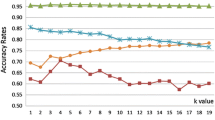Abstract
A very important part of machine learning is classification. One of the most important classification algorithms is the k-nearest neighbour algorithm. This algorithm works on the principle that a point belongs to the same class as the majority of its closest neighbours. In this approach, a point qualifies as one of the closest neighbours of another point based on the parameter ‘k’. We determine whether a point has a bearing on another neighbour’s class if it is one of the first ‘k’-nearest neighbours of the point in question. A major disadvantage of this algorithm is the fact that we are bound to take exactly ‘k’-nearest neighbours irrespective of the distance between a point and the neighbour. This is a major anomaly. We decide that we shall determine the importance of a point in an algorithm based on proximity to another point but do not pay any heed to the distance between those two points. Many solutions have been proposed to reduce the effect of this problem in the algorithm. This paper gets rid of this problem altogether and adds another dimension to the nearest neighbour classification model.
Access this chapter
Tax calculation will be finalised at checkout
Purchases are for personal use only
Similar content being viewed by others
References
Zhang, Y.X., Li, L.L., Zhao, Y.H.: k-nearest neighbors for automated classification of celestial objects. Sci. China, Ser. G 51(7), 916–922 (2008)
Vitola, J., Pozo, F., Tibaduiza, D., Maribel, A.: A sensor data fusion system based on k-nearest neighbor pattern classification for structural health monitoring applications. Sensors 1–26 (2017)
Akhil Jabbar, M., Deekshatulu, B.L., Chandra, P.: Classification of heart disease using K-nearest neighbor and genetic algorithm. In: International Conference on Computational Intelligence: Modeling Techniques and Applications (CIMTA), pp. 85–94 (2013)
Krati Saxena, D., Khan, Z., Singh, S.: Diagnosis of diabetes mellitus using K nearest neighbor algorithm. Int. J. Comput. Sci. Trends Technol. (IJCST) 2(4) (2014)
Dudani, S.A.: The distance-weighted k-nearest neighbor rule. IEEE Trans. Syst. Man Cybern. 6, 325–327 (1976)
Gou, J., Du, l, Zhang, Y., Xiong, T.: A new distance-weighted k-nearest neighbor classifier. J. Inf. Comput. Sci. 9(6), 1429–1436 (2012)
Nitin Bhatia, V.: Survey of nearest neighbor techniques. Int. J. Comput. Sci. Inf. Secur. 8(2), 302–305 (2010)
Yu, Z., Chen, H., Liu, J., You, J., Leung, H., Han, G.: Hybrid K nearest neighbours classifier. IEEE Trans. Cybern. 46(6), 1263–1275 (2016)
Xie, Y.: KNN++: an enhanced K-nearest neighbor approach for classifying data with heterogeneous views. Adv. Intell. Syst. Comput. 13–23 (2015)
Madhuri, R., RamakrishnaMurty, M., Murthy, J.V.R., Prasad Reddy, P.V.G.D, et al.: Cluster analysis on different data sets using K-modes and K-prototype algorithms. In: International Conference and Published the Proceeding in AISC and Computing, vol. 249, pp 137–144. Springer, (2014)
Jiang, l., Cai, Z., Dianhong, W., Jiang, S.: Survey of improving k-nearest neighbour for classification. In: Fourth International Conference on Fuzzy Systems and Knowledge Discovery (FSKD 2007), IEEE Explore
Author information
Authors and Affiliations
Corresponding author
Editor information
Editors and Affiliations
Rights and permissions
Copyright information
© 2020 Springer Nature Singapore Pte Ltd.
About this paper
Cite this paper
Bandyopadhyay, R. (2020). Varying k-Nearest Neighbours: An Attempt to Improve a Widely Used Classification Model. In: Satapathy, S., Bhateja, V., Mohanty, J., Udgata, S. (eds) Smart Intelligent Computing and Applications . Smart Innovation, Systems and Technologies, vol 159. Springer, Singapore. https://doi.org/10.1007/978-981-13-9282-5_1
Download citation
DOI: https://doi.org/10.1007/978-981-13-9282-5_1
Published:
Publisher Name: Springer, Singapore
Print ISBN: 978-981-13-9281-8
Online ISBN: 978-981-13-9282-5
eBook Packages: Intelligent Technologies and RoboticsIntelligent Technologies and Robotics (R0)




